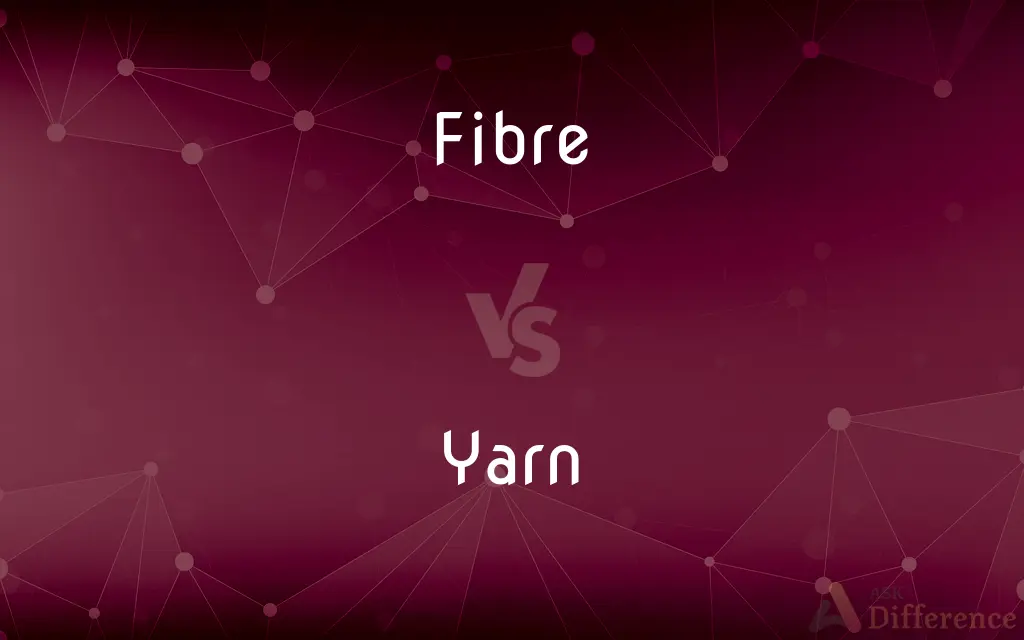Fibre vs. Yarn — What's the Difference?
By Tayyaba Rehman & Maham Liaqat — Updated on April 4, 2024
Fibre refers to natural or synthetic strands used as the building blocks in textile production, while yarn is a long, continuous length of interlocked fibres, spun from natural or synthetic fibres, used for knitting, weaving, or sewing.

Difference Between Fibre and Yarn
Table of Contents
ADVERTISEMENT
Key Differences
Fibre is the most fundamental component in the production of textiles, representing the raw material, such as cotton, wool, polyester, or nylon, which can be natural or synthetic. These fibres are characterized by their fineness, length, and strength, which determine their suitability for various textile applications. On the other hand, yarn is created by spinning fibres together, twisting them to form a cohesive and continuous strand. This process aligns the fibres, enhancing their collective strength and preparing them for use in fabric creation through knitting, weaving, or crocheting.
While fibres can vary widely in their properties, including their texture, durability, and moisture-wicking capabilities, yarns are defined by how these fibres are spun together, influencing the yarn's thickness, strength, elasticity, and final appearance. For instance, fibres like silk and wool have distinct characteristics, such as silk's smoothness and wool's warmth, which translate into the yarn's properties once spun.
The transformation from fibre to yarn is crucial in textile manufacturing, with the spinning process itself being a determinant in the yarn's end use. Fibres intended for luxurious fabrics, for example, may be spun differently than those for durable, everyday clothing. This distinction highlights the importance of both the fibres' inherent qualities and the spinning method in determining the yarn's application.
The distinction between fibre and yarn is also significant in environmental terms. Natural fibres, sourced from plants and animals, have different environmental impacts compared to synthetic fibres made from petroleum products. However, once these fibres are spun into yarn, the focus shifts to the yarn's production process, including energy consumption, dyeing, and finishing, which can further differentiate the environmental footprint of the final textile product.
In the realm of arts and crafts, the choice between different fibres and yarns can drastically affect the texture, drape, and coloration of the finished piece. Artists and craftsmen select specific fibres and yarns based on the desired aesthetic and functional qualities of their projects, showcasing the creative potential unleashed through the interplay of different materials.
ADVERTISEMENT
Comparison Chart
Definition
The basic unit, natural or synthetic, used in making textiles.
A long, continuous length of interlocked fibres.
Source
Plants (cotton), animals (wool), minerals (asbestos), synthetic (polyester).
Spun from natural or synthetic fibres.
Form
Short strands or filaments.
Continuous strands created by spinning fibres.
Properties
Texture, durability, moisture-wicking capabilities.
Thickness, strength, elasticity, appearance.
End Use
Raw material for textile production.
Knitting, weaving, crocheting to create fabrics.
Compare with Definitions
Fibre
Varied in properties based on source.
Wool fibres offer natural warmth and moisture-wicking capabilities.
Yarn
Continuous strand of interlocked fibres.
She chose a soft, chunky yarn for her knitting project.
Fibre
Natural or synthetic strand used in textiles.
Cotton fibres are popular for their softness and breathability.
Yarn
Can be made from various fibres.
Alpaca yarn is known for its warmth and softness.
Fibre
Can be spun into yarn.
Polyester fibres are often used to produce strong, durable yarns.
Yarn
Selection based on end-use requirements.
For the summer dress, a lightweight cotton yarn was used.
Fibre
The smallest unit in textile production.
Silk fibre is prized for its natural sheen and strength.
Yarn
Used in knitting, weaving, and sewing.
The yarn was dyed in vibrant colors for the tapestry.
Fibre
Environmental impact depends on the type.
Bamboo fibres are considered more eco-friendly due to their renewable source.
Yarn
Properties influenced by spinning process.
The tightly spun yarn was perfect for durable socks.
Fibre
A thread or filament from which a vegetable tissue, mineral substance, or textile is formed
The basket comes lined with natural coco fibres
Yarn
Yarn is a long continuous length of interlocked fibres, suitable for use in the production of textiles, sewing, crocheting, knitting, weaving, embroidery, or ropemaking. Thread is a type of yarn intended for sewing by hand or machine.
Fibre
Dietary material containing substances such as cellulose, lignin, and pectin, that are resistant to the action of digestive enzymes.
Yarn
A continuous strand of twisted threads of natural or synthetic fibers, such as wool or nylon, used in weaving or knitting.
Fibre
Variant of fiber.
Yarn
A similar strand of other materials such as glass or plastic.
Fibre
(countable) A single piece of a given material, elongated and roughly round in cross-section, often twisted with other fibres to form thread.
The microscope showed several different fibres stuck to the sole of the shoe.
Yarn
(Informal) A long, often elaborate narrative of real or fictitious adventures; an entertaining tale.
Fibre
(uncountable) Material in the form of fibres.
The cloth was made from strange, somewhat rough fibre.
Yarn
To tell an entertaining tale or series of tales.
Fibre
Dietary fibre.
Fresh vegetables are a good source of fibre.
Yarn
(uncountable) A twisted strand of fiber used for knitting or weaving.
Fibre
Moral strength and resolve.
The ordeal was a test of everyone’s fibre.
Yarn
(nautical) Bundles of fibers twisted together, and which in turn are twisted in bundles to form strands, which in their turn are twisted or plaited to form rope.
Fibre
(mathematics) The preimage of a given point in the range of a map.
Under this map, any two values in the fibre of a given point on the circle differ by 2π
Yarn
(countable) A story, a tale, especially one that is incredible.
Fibre
(category theory) Said to be of a morphism over a global element: The pullback of the said morphism along the said global element.
Yarn
To tell a story or stories, especially one that is lengthy or unlikely to be true.
Fibre
(computing) A kind of lightweight thread of execution.
Yarn
Spun wool; woolen thread; also, thread of other material, as of cotton, flax, hemp, or silk; material spun and prepared for use in weaving, knitting, manufacturing sewing thread, or the like.
Fibre
(cytology) A long tubular cell found in bodily tissue.
Yarn
One of the threads of which the strands of a rope are composed.
Fibre
Same as fiber.
Yarn
A story told by a sailor for the amusement of his companions; a story or tale; as, to spin a yarn.
Fibre
A slender and greatly elongated solid substance
Yarn
The act of giving an account describing incidents or a course of events;
His narration was hesitant
Fibre
The inherent complex of attributes that determine a persons moral and ethical actions and reactions;
Education has for its object the formation of character
Yarn
A fine cord of twisted fibers (of cotton or silk or wool or nylon etc.) used in sewing and weaving
Fibre
A leatherlike material made by compressing layers of paper or cloth
Yarn
Tell or spin a yarn
Common Curiosities
How do natural and synthetic fibres differ?
Natural fibres come from plants, animals, or minerals and are renewable and biodegradable, while synthetic fibres are man-made, often from petroleum, and offer different strengths and weaknesses in durability, care, and environmental impact.
What distinguishes fibre from yarn?
Fibre refers to the raw material, either natural or synthetic, used in textiles, while yarn is the product of spinning these fibres together into a continuous strand.
Can all fibres be made into yarn?
Most fibres, with their varied properties, can be spun into yarn, although the resulting yarn's characteristics depend on the fibre's qualities.
What role does yarn play in fabric production?
Yarn is the intermediate product used to create fabrics through techniques like knitting, weaving, and crocheting, determining the fabric's texture, strength, and appearance.
Can yarn properties be altered after production?
Yes, yarn properties can be modified through dyeing, stretching, or chemical treatments to enhance performance, colorfastness, or aesthetic appeal.
Why would an artist choose a specific yarn or fibre?
Artists and craftsmen select fibres and yarns based on desired textural, aesthetic, and functional qualities for their specific projects, from fine arts to practical crafts.
Why is the spinning process important in yarn production?
Spinning aligns fibres and imparts strength, elasticity, and uniformity to the yarn, affecting its final application and quality.
Can the dyeing process affect the quality of the yarn?
The dyeing process can indeed affect the yarn's quality, potentially impacting its colorfastness, texture, and strength. The method and timing of dyeing (before or after spinning) can also influence the yarn's final appearance and properties.
How do environmental impacts compare between fibres and yarns?
The environmental impact varies widely among different fibres and is further influenced by the yarn production process, including energy consumption and chemical use.
What factors influence the choice of fibre for yarn making?
Factors include the intended use of the yarn (such as for clothing, upholstery, or industrial use), desired properties (strength, elasticity, moisture-wicking), and environmental considerations (renewability, biodegradability).
How does the thickness of yarn affect its use?
The thickness of the yarn (also known as its weight) determines its suitability for different projects, with finer yarns used for delicate, detailed work, and thicker yarns preferred for bulkier, warmer items.
Is there a difference in care between natural fibre yarns and synthetic fibre yarns?
Yes, natural fibre yarns may require more careful handling, such as hand washing or specific temperature settings, to maintain their texture and appearance, while synthetic fibre yarns often offer greater durability and ease of care, including machine washing.
How do manufacturers ensure the consistency of yarn properties?
Manufacturers control the consistency of yarn properties through standardized processes in spinning, twisting, and finishing, as well as through quality control tests that measure strength, elasticity, and uniformity, ensuring that the yarn meets specific standards and requirements for its intended use.
Share Your Discovery

Previous Comparison
Matriculate vs. Graduate
Next Comparison
Glow vs. GrowAuthor Spotlight
Written by
Tayyaba RehmanTayyaba Rehman is a distinguished writer, currently serving as a primary contributor to askdifference.com. As a researcher in semantics and etymology, Tayyaba's passion for the complexity of languages and their distinctions has found a perfect home on the platform. Tayyaba delves into the intricacies of language, distinguishing between commonly confused words and phrases, thereby providing clarity for readers worldwide.
Co-written by
Maham Liaqat















































